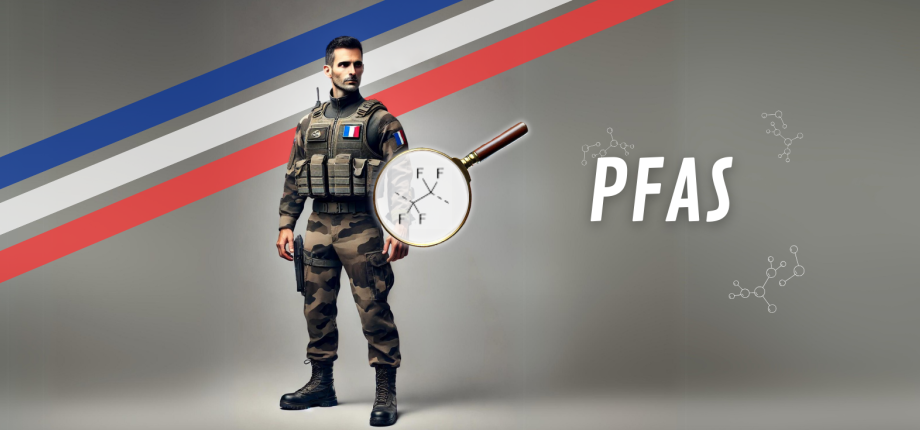PFAS-free alternatives for combat clothing

Being waterproof and resistant to greasy substances such as oil is a very practical property. Many textiles are now marketed with these properties, facilitating our outdoor activities or forming protective coverings for sofas and carpets. But for military outfits, it's much more than a practical issue: preventing water and oil penetration is essential to protect against CBRN (nuclear, radiological, biological and chemical) warfare toxins. At present, this “amphiphobic” property is acquired by molecules known as PFAS. However, these molecules are both toxic and long-lasting in the environment, so much so that they are referred to as “ forever chemicals”. As a result, their use is increasingly restricted. This is why the French Direction Générale de l'Armement (DGA) and the Agence de l'Innovation de Défense (AID) have turned to CIEDS and scientists at Institut Polytechnique de Paris, to find alternatives to PFAS for future armed forces uniforms. This is the objective of Amphitex.
PFASs, a generic acronym for perfluoroalkyl and polyfluoroalkyl molecules, are characterized by chains of carbon atoms bound to fluorine atoms. This bond between fluorine and carbon atoms is one of the strongest chemical bonds, making PFAS coatings highly stable and resistant, but also causing persistent pollution once the molecules have been disseminated. “The very low surface energy of PFAS is the reason why it repels both water and oil, and there are no other molecules as effective as it from this point of view!” stresses Anne-Chantal Gouget, chemist at the Laboratory of Condensed Matter for Physics * (PMC) at École Polytechnique and scientific manager of the Amphitex project. Not to mention that the textile must retain its properties of breathability and resistance to mechanical stress and washing. What's more, the design process has to be both environmentally and health-friendly, while also being industrializable, in line with AID and DGA specifications. The challenge is therefore considerable.
To meet this challenge, scientists from 5 research teams in 3 IP Paris laboratories joined forces: the Laboratory of Condensed Matter for Physics (PMC), the ORganic Synthesis Laboratory** (LSO) and the Chemistry and Process Unit* (UCP). The strategy pursued is similar to that found in nature, for example in lotus leaves, which possess hydrophobic (water-resistant) and oleophobic ( oil-resistant) properties, without PFAS. “If you look at a lotus leaf under a microscope, you'll see a multi-scale structure, i.e. first roughness on a micrometric scale and then, zooming in even further, on a nanometric scale. The whole thing is covered by a hydrophobic molecule,” explains Anne-Chantal Gouget.
She and her colleagues are tackling the problem from different angles. The first line of research concerns fabric “activation”. This is a treatment that enables molecules on the textile surface to acquire different chemical functions, in this case groups of atoms that will facilitate the subsequent bonding of a coating. Several treatments are being tested, including exposure to UV rays and ozone (known as UV-ozonolysis) or plasmas (ionized gases of different species), a process for which the team also benefits from the expertise of IP Paris' Plasma Physics Laboratory.
In parallel, the Amphitex project is developing the synthesis of PDMS (polydimethylsiloxane) molecules, a molecule known for its hydrophobic properties, and which the researchers have already succeeded in optimizing since the beginning of the project. This molecule is intended to be grafted - attached - to the activated textile, for example by directly impregnating the fabric or by forming branches through polymerization, in order to structure the surface, much like lotus leaves. To take this multi-scale structuring a step further, the researchers are also experimenting with the addition of inorganic particles, such as silica beads or zinc oxide rods. “For each of these areas of research, we are testing different strategies to determine the best one,” emphasizes Anne-Chantal Gouget.
These are the building blocks that the researchers are gradually putting together. “Improving the oleophobic (oil-resistant) character is one of the biggest challenges, but in the space of a year, we have already obtained promising results”, says Amphitex's scientific manager. The team is considering patenting some of the processes it has developed. In addition to military applications, the project could have other uses, as PFAS are present in many products other than textiles, for example in kitchen tool coatings or medical devices.
Being waterproof and resistant to greasy substances such as oil is a very practical property. Many textiles are now marketed with these properties, facilitating our outdoor activities or forming protective coverings for sofas and carpets. But for military outfits, it's much more than a practical issue: preventing water and oil penetration is essential to protect against CBRN (nuclear, radiological, biological and chemical) warfare toxins. At present, this “amphiphobic” property is acquired by molecules known as PFAS. However, these molecules are both toxic and long-lasting in the environment, so much so that they are referred to as “ forever chemicals”. As a result, their use is increasingly restricted. This is why the French Direction Générale de l'Armement (DGA) and the Agence de l'Innovation de Défense (AID) have turned to CIEDS and scientists at Institut Polytechnique de Paris, to find alternatives to PFAS for future armed forces uniforms. This is the objective of Amphitex.
Being waterproof and resistant to greasy substances such as oil is a very practical property. Many textiles are now marketed with these properties, facilitating our outdoor activities or forming protective coverings for sofas and carpets. But for military outfits, it's much more than a practical issue: preventing water and oil penetration is essential to protect against CBRN (nuclear, radiological, biological and chemical) warfare toxins. At present, this “amphiphobic” property is acquired by molecules known as PFAS. However, these molecules are both toxic and long-lasting in the environment, so much so that they are referred to as “ forever chemicals”. As a result, their use is increasingly restricted. This is why the French Direction Générale de l'Armement (DGA) and the Agence de l'Innovation de Défense (AID) have turned to CIEDS and scientists at Institut Polytechnique de Paris, to find alternatives to PFAS for future armed forces uniforms. This is the objective of Amphitex.
Environmentally and healthy friendly
PFASs, a generic acronym for perfluoroalkyl and polyfluoroalkyl molecules, are characterized by chains of carbon atoms bound to fluorine atoms. This bond between fluorine and carbon atoms is one of the strongest chemical bonds, making PFAS coatings highly stable and resistant, but also causing persistent pollution once the molecules have been disseminated. “The very low surface energy of PFAS is the reason why it repels both water and oil, and there are no other molecules as effective as it from this point of view!” stresses Anne-Chantal Gouget, chemist and scientific manager of the Amphitex project. Not to mention that the textile must retain its properties of breathability and resistance to mechanical stress and washing. What's more, the design process has to be both environmentally and health-friendly, while also being industrializable, in line with AID and DGA specifications. The challenge is therefore considerable.
To meet this challenge, scientists from 5 research teams in 3 IP Paris laboratories joined forces: the Laboratory of Condensed Matter for Physics (PMC*), the Organic Synthesis Laboratory (LSO**) and the Chemistry and Process Unit (UCP***). The strategy pursued is similar to that found in nature, for example in lotus leaves, which possess hydrophobic (water-resistant) and oleophobic ( oil-resistant) properties, without PFAS. “If you look at a lotus leaf under a microscope, you'll see a multi-scale structure, i.e. first roughness on a micrometric scale and then, zooming in even further, on a nanometric scale. The whole thing is covered by a hydrophobic molecule,” explains Anne-Chantal Gouget.
She and her colleagues are tackling the problem from different angles. The first line of research concerns fabric “activation”. This is a treatment that enables molecules on the textile surface to acquire different chemical functions, in this case groups of atoms that will facilitate the subsequent bonding of a coating. Several treatments are being tested, including exposure to UV rays and ozone (known as UV-ozonolysis) or plasmas (ionized gases of different species), a process for which the team also benefits from the expertise of IP Paris' Plasma Physics Laboratory.
Like lotus leaves
In parallel, the Amphitex project is developing the synthesis of PDMS (polydimethylsiloxane) molecules, a molecule known for its hydrophobic properties, and which the researchers have already succeeded in optimizing since the beginning of the project. This molecule is intended to be grafted - attached - to the activated textile, for example by directly impregnating the fabric or by forming branches through polymerization, in order to structure the surface, much like lotus leaves. To take this multi-scale structuring a step further, the researchers are also experimenting with the addition of inorganic particles, such as silica beads or zinc oxide rods. “For each of these areas of research, we are testing different strategies to determine the best one,” emphasizes Anne-Chantal Gouget.
These are the building blocks that the researchers are gradually putting together. “Improving the oleophobic (oil-resistant) character is one of the biggest challenges, but in the space of a year, we have already obtained promising results”, says Amphitex's scientific manager. The team is considering patenting some of the processes it has developed. In addition to military applications, the project could have other uses, as PFAS are present in many products other than textiles, for example in kitchen tool coatings or medical devices.
About:
Anne-Chantal Gouget is a CNRS research director, deputy director of the Condensed Matter Physics Laboratory at École Polytechnique, chemist and scientific leader of the Amphitex project.
*PMC: a joint research unit CNRS, École Polytechnique, Institut Polytechnique de Paris, 91120 Palaiseau, France
**LSO: a joint research unit CNRS, ENSTA Paris, École Polytechnique, Institut Polytechnique de Paris, 91120 Palaiseau, France
***UCP: a research lab ENSTA Paris, Institut Polytechnique de Paris, 91120 Palaiseau, France














